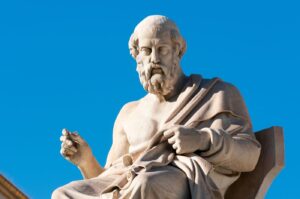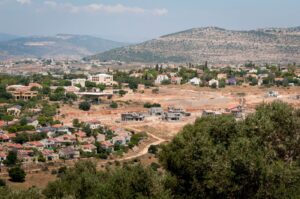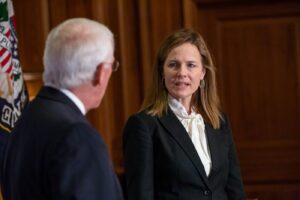Those for whom the cognitive embers of art history 101 are sufficiently aglow will recall that Western medieval architecture hinged upon the shift from the round-arched, relatively dark Romanesque style to the pointed, light-infused glory of Gothic. In 1907, New York City saw that very moment repeated, on a scale equal to Chartres or Amiens. Ralph Adams Cram, an emerging Gothic architect, was chosen to take over the partially constructed Romanesque plan of a rising Episcopal Cathedral, creating what has become, arguably, the largest Gothic structure in the world: St. John the Divine. Cram, a contemporary (and some would say an equal) of Frank Lloyd Wright, was up to far more than building. Surveying the wreckage of Western civilization after World War I, he envisioned, along with Ortega y Gasset and Nikolai Berdyaev, a New Medievalism. Cram criticized his time severely, its superstitious progressivism, capitalist excesses, unrestrained rationalism, and the moral dilution of “social democracy.” The antidote to this contemporary disease was in the supernatural hope, guilds and agrarianism, pre-Cartesian philosophy, and “creative aristocracy” of the Middle Ages. Cram’s Cathedral, built upon the “American Acropolis” in Manhattan’s Morningside Heights, was to be the New Medievalism’s chief expression. “We are getting our running start, we are retracing our steps to the great Christian Middle Ages, not that there we may remain, but that we may achieve an adequate point of departure.” Cram, whose architectural firm endures, was America’s John Ruskin, always insisting that medieval inspiration could make “a vital contribution to modern life.”
The architect’s hopes, of course, went unfulfilled. The Middles Ages were not repeated, and in September of 1939, what had been dubbed the War to End All Wars, was. In addition, the conceits of architectural modernism outlawed the Gothic style (a fiat that, in some quarters, still endures). Consequently, like most great Cathedrals, St. John the Divine remains incomplete, leading to its nickname “St. John the Unfinished.” Cram himself never got around to a planned reredos. Countless other contributors, be they modern stone carvers or even contemporary artists, have attempted to move the Cathedral towards completion. Such artistic intrusions would not have unsettled Cram. He tirelessly promoted “the intimate bond that unites art and religion in a common service.” Cram had an unusually high view of art that was buoyed by his Christian faith, but was not necessarily limited to those who share it:
[I]n all its manifestations, whether as architecture, painting, sculpture, drama, poetry, or ritual, [art] is the only visible and concrete expression of this mystical power in man which is greater than physical force, greater than physical mind, whether with [Henri] Bergson we call it intuition or with Christian philosophers we call it the immortal soul.
Because of this exalted view of art, Cram believed that it “can be an agency working toward the redemption of human character.” Art, therefore, takes “something of that quality which characterizes the ministry of the Christian church.” Of course, artists don’t always function as these “ministers of minor orders” (and Cram did not hesitate to chastise them when they did not).
Start your day with Public Discourse
Sign up and get our daily essays sent straight to your inbox.The Crossing, by the Cuban-American artist Enrique Martínez Celaya, is the current installation of contemporary art at St. John the Divine (on view through November 23rd). Martínez Celaya, while perhaps not considering himself a “minister of minor orders,” is certainly haunted by Biblical themes. Consequently, the four large canvases in the Cathedral are an extension of the same artist’s exhibition entitled The Wanderer at the Museum of Biblical Art (on view through December 23). I find myself in agreement with R.R. Reno’s Augustinian reflections on Martínez Celaya’s work.
His skillfully executed paintings and sculptures offer just the kind of bittersweet brooding one expects from the art world at its best. Martínez Celaya’s melancholic surfaces absorb the viewer into an inviting December chill, offering windy blasts of 21st century irresolution. A vulnerable youth, for example, stands before two ambivalent pine trees not quite fit for Christmas, as if to counter undemanding, generic holiday imagery. Like nearly all contemporary artists, Martínez Celaya questions certainty. Still, in the MOBiA exhibition, his interrogations are presided over by the shelves of antique Bibles innocently presiding above. This dynamic—between artistic questions and religious answers—is intensified in the Cathedral.
The brilliance of the St. John the Divine installation is in the placement, providing an exquisite contrast between Ralph Adams Cram’s ideals and our own. The soaring expanse of St. John’s nave is perhaps best experienced as offset by Martínez Celaya’s less confident ruminations. Likewise, Martínez Celaya’s paintings may have found their most fitting context in these hospitable bays of glass and stone. The rubies in the window dedicated to great missionaries like Bartolomé de las Casas (defender of indigenous South Americans) are juxtaposed with a large canvas of a crippled boy decked with much less celebratory jewels, waiting for a missionary that will not come. The Cathedral’s communications window, which celebrates technology, is contrasted with Martínez Celaya’s painting of a dark, puddled corner of the very earth from which we fear our technology alienates us. A window dedicated to sacrificial heroes of Anglican history is contrasted with a painting of an empty boat, from which no water-walking disciple has lately emerged. Most interestingly, the window dedicated to crusaders mounted on their white horses, is juxtaposed with a painting of a figure on a storm-swept beach, which appears to dismount the same white horse.
Everyone loves to hate the Crusades, and I doubt the progressive Episcopalians of St. John the Divine make that particular window a regular tour stop. This moment of European history has been so caricatured that ranking scholars of the subject, such as Jonathan Riley Smith, have given up on convincing the public of the period’s complexity — a complexity that St. John the Divine’s Crusader window embraces. The window does not glorify violence, but depicts the crusaders’ misfortunes as well as their victories. Furthermore, it collocates the warriors of the Middle Ages with more recent figures, such as the anti-slavery crusader William Wilberforce, or tireless doctors who made breakthroughs against diseases, the names of which we—thanks to such doctors—no longer even recognize. The Crusades function, at St. John the Divine, as a wider emblem for any cause worthy of sacrifice. The generation that erected St. John the Divine had fought in the Great War. They knew sacrifice; and they could therefore recognize, and honor it, in the past.
Ralph Adams Cram, to be sure, could go rhetorically overboard when glorifying the great Christian Middle Ages. But we too have gone overboard in despising so many of the things the windows of St. John the Divine exalt.
Martínez Celaya’s paintings at the Cathedral almost perfectly instantiate this contrast between Cram, who uplifted medieval ideals, and our era, which professionally questions them. To be sure, the religiously minded among us will benefit from Martínez Celaya’s humbling doses of prevarication. But the present generation has need for the invigorating smelling salts of Cram’s celebratory windows as well. To put it bluntly, Cram needs Martínez Celaya, and Martínez Celaya needs Cram.
“The best lack all conviction, while the worst are full of passionate intensity,” reads the overquoted Yeats line. But lack of conviction more frequently afflicts the average, and passion of some variety almost always animates the best. Unicorns, of course, are mythical; but there are such things as white horses, unsullied causes worthy of our sullied efforts. There are things worth fighting for, including perhaps, a New Medievalism. Cram frequently overdid it, but his was a calculated intensity which took its cues from the severity of the problems the architect aimed to solve. It is uncanny how many of our contemporary ills, whether social dislocation, institutionalized materialism, technological oversaturation or cultural decline, are addressed by solutions similar to those offered by Cram’s bracing neo-medieval rhetoric. Enrique Martínez Celaya, we can imagine, might agree. A new generation, having overdosed on irony, could capitalize on the artist’s intentional ambiguity, and wonder if the elusive figure below the crusading window is not dismounting a white horse, but getting back on.










